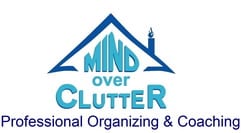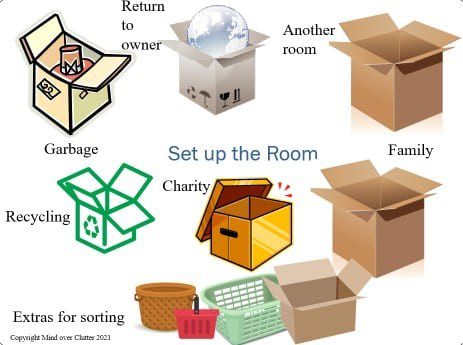Before hiring a moving company in St Catharines & the Niagara Region declutter and then organize with Julie Stobbe at Mind over Clutter
This article was first published by JR Moving Services
Just because something brought you joy in the past doesn’t mean you should carry it forever. The possessions you keep should represent the person you are trying to become, not the person you were. Keep this in mind when you start your decluttering journey. As you start to let go of things it will become easier and easier. Here are steps to help you on your path to finding your treasures.
Planning the space
Decide what the goal is for the room. Is it to have a:
- Beautiful compact space
- Functional workshop
- Sense of freedom and control
- the Joy of financially exchanging stuff for new experiences and pleasures.
- Clear out a parent’s home
- Make things easier for the next generation
- Streamline your lifestyle
Make a floor plan
Decide what you want the room to look like and be used for. Draw a floor plan and make a list of activities that happen in that space. It will help you to know what to keep.
Decision criteria
Set up some questions to help you with your decision making. Here are some examples:
- How many of these do I have? How many is enough?
- Does the item fit in with my values?
- Is this item current?
- Is this item really valuable?
- Will owning this help to resolve my clutter?
- What is the worst thing that can happen if I don’t have it?
- If I need it, can I borrow it from somewhere?
- Does it bring me joy?
- Do you need it?
How much is enough?
Look around the room and decide what percentage of stuff you need to give away so everything will fit into the room. 25% 50% 75%?
If you don’t schedule it, it won’t get done.
Schedule the time and do it when you are not rushed. Do one area, room, box or even corner of a room depending on how much stuff you have to go through and your deadline.
Prepare the room for working.
You will need a series of boxes, bins, bags or containers for garbage, recycling, donations, items to go to other rooms, and items to return to people.
5 Methods for decluttering the room
I’m going to go through a number of ways to sort through your items and you can decide what method works best for you. At first, decluttering is easy because you find items that you know you don’t want and just haven’t given them away yet. Then it becomes more challenging. You must chip away at identifying which items are true treasures versus those you feel guilty about giving away. Remember to reduce by the percentage you choose in your planning.
1. Have a box
The simplest way to start is to keep a box in your closet and whenever you find something you don’t need put it into the box and you can start decluttering right away.
2. Skimming
- Go to a closet/cupboard and select the best items in each category.
- Most cupboards/closets will have more than one category.
- For example, in a kitchen, the cupboard might have baking dishes, casserole dishes, muffin tins, and loaf pans. Pick the best 1 or 2 of each of these 4 categories and donate the rest.
- Continue to open each cupboard and drawer skimming the contents and selecting 1 or 2 items from each category.
3. Sort then declutter
- Go clockwise around the room sorting items into groups by function
- Do the surfaces first and then the drawers and cupboards next
- When you are done, the garbage and recycling will be collected and removed from the room
- All the items in the room will be in groups
- Each room will have different categories/groups of items. Here are some examples, books, electronics, tools, dishes, home decor, games, clothing, photos etc
Look at one category/group and apply the questions and percentage you determined in the planning stage. Start removing items you don’t need and donate them.
If that method doesn’t work for you and you are keeping everything, try a different method.
4. Grouping
Keep the Best of the Best. Instead of thinking about giving things away, it might be easier to think about keeping the best.
- After you have sorted the room make sure you are keeping the best one. You need to see all of the items in one group together and keep only as many as you need or the percentage you set in the planning stage, keep the best ones.
5. Triage
- Gather all your items from one category
- Pick up the first three and remove the one you like the least.
- Pick up 3 more and remove one again
- After you have gone through the category/group you will have decluttered by 1/3
If you are sentimental
- Try taking a picture of the items so you have the memory and let go of the item.
- Find a good home for the things you are letting go of, they are still useful just not to you anymore.
- “Shrink it”, only keep one item from a collection instead of the entire collection, you will still have the memory
- Ask yourself, what would be best, having a number of boxes with large quantities of unsorted keepsakes or a carefully assembled box of very precious treasures?
Mindset
Decluttering is about having a mindset of letting go and having less. Once you experience the joy of being unburdened from cleaning, organizing, buying, and repairing stuff you don’t need, want, use or like you’ll wonder why you didn’t start sooner. Enjoy the journey.
Moving Companies rely on businesses like Mind Over Clutter. If you are in the rightsizing process check out our partners at Mind over Clutter. They service St. Catharines and The Niagara Region and can give you some great insight and help you through this process!
 Julie Stobbe is a Trained Professional Organizer and Lifestyle Organizing Coach who brings happiness to homes and organization to offices, coaching you virtually over Zoom. She has been working with clients since 2006 to provide customized organizing solutions to suit their individual needs and situations. She guides and supports you to manage your time, and projects and reach your goals. If you’re in a difficult transition Julie can coach you to break-free of emotional clutter constraining you from living life on your terms. Online courses are available to help instruct, coach and support your organizing projects. Get started by downloading Tips for Reorganizing 9 Rooms.
Julie Stobbe is a Trained Professional Organizer and Lifestyle Organizing Coach who brings happiness to homes and organization to offices, coaching you virtually over Zoom. She has been working with clients since 2006 to provide customized organizing solutions to suit their individual needs and situations. She guides and supports you to manage your time, and projects and reach your goals. If you’re in a difficult transition Julie can coach you to break-free of emotional clutter constraining you from living life on your terms. Online courses are available to help instruct, coach and support your organizing projects. Get started by downloading Tips for Reorganizing 9 Rooms.
Contact her at julie@mindoverclutter.ca



Great tips, Julie! It is also helpful to remember how large the new home will be to determine how much to reduce. So, if you are going to a house that is 50% smaller, start by reducing at least 50% of the stuff in each room. If there are rooms you will not have in your new home, you can reduce those rooms by 90%.
Thanks for commenting on “not having a room” in your new home. Planning for where things go and get stored before the move helps with the unpacking. Realizing that things can’t go in the same place in the new home as in the old home makes decluttering and organizing your home simple because before you move you have time to think after you move you may feel overwhelmed solving unpacking problems.
I’ve recently discovered something about sentimental items. I don’t know if it’s just me or if it’s the same for others, but I realized that many of my keepsakes aren’t even important to me; I’ve just held onto them because they’re keepsakes. Maybe it’s time for me to do some Swedish death cleaning!
I agree that valuable sentimental items change with time. It is interesting that as you change what is important to hold onto from the past changes. Knowing that things change is important so you don’t feel guilty about letting go of things.
I really love the idea of going around the room clockwise. This makes sense because you can have logical starting and stopping points, which is particularly helpful if you have to work in small bits of time.
It’s funny, even after doing all the decluttering, it seems we still end up with items we don’t want on the other end of a move. I always set up a “donation” bin when I do an unpack.
I agree that no matter how well you plan there will be an area that doesn’t hold what you thought you need, you won’t have as much space as you thought so you need to declutter again. I reassure people that it is normal.
Decluttering can be overwhelming, but you shared many ideas to make the process more doable. I love your suggestion for sentimental clutter to “shrink it.” I had never heard that term before. It’s a great way to keep something from a treasured collection without the need to keep each piece, especially if you don’t have space for it.
It’s also worth decluttering at different stages because our needs and goals change. With those changes in focus, the “stuff” of life can change too.
It is really important to know that as the focus of your life changes what is important to you and it is alright to let go of things that were once important.
I love the vivid, easy approaches of “skimming” and “shrinking” when letting go of these items. So often, we ask ourselves “keep or let go” for item and item, but that’s a 50/50 proposition. But by looking at a category and picking the most appreciated, the best, you are operating from a position of abundance. All of these are great tips.
It is important to know about yourself or your client if asking them to let go of things they don’t need or asking them to keep the best one will work for them.